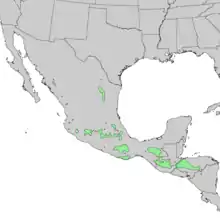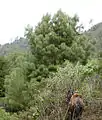Pinus pseudostrobus
Pinus pseudostrobus, known in English as the smooth-bark Mexican pine and in Spanish as chamite or pacingo, is a tree found in forests of Mexico and Central America.[1][2][6] It is 8 to 25 m tall with a dense and round top.It is threatened by logging and wood harvesting.[1] The bark is brown and fissured and smooth when young. It is subject to ex-situ conservation.[1] It grows at altitudes between 850 and 3250 m. from 26° to 15° north latitude, from Sinaloa, Mexico to Nicaragua and Honduras. It occurs within a rainfall regime that rains mostly in summer.
| Pinus pseudostrobus | |
|---|---|
 | |
| var. apulcensis in cultivation | |
| Scientific classification | |
| Kingdom: | Plantae |
| Clade: | Tracheophytes |
| Clade: | Gymnosperms |
| Division: | Pinophyta |
| Class: | Pinopsida |
| Order: | Pinales |
| Family: | Pinaceae |
| Genus: | Pinus |
| Subgenus: | P. subg. Pinus |
| Section: | P. sect. Trifoliae |
| Subsection: | P. subsect. Ponderosae |
| Species: | P. pseudostrobus |
| Binomial name | |
| Pinus pseudostrobus | |
 | |
| Natural range of Pinus pseudostrobus. Pinus pseudostrobus is also found in El Salvador.[2] | |
| Synonyms | |
|
Pinus astecaensis Roezl ex Gordon[4] Pinus coatepecensis (Martínez)Gaussen[3] Pinus estevezii (Martínez) J.P.Perry[3] Pinus nubicola J.P.Perry[3] Pinus oaxana Mirov[4] Pinus yecorensis Debreczy & I.Ràcz | |
A stand of about 15 fully mature smooth-bark Mexican pines is in Imperial County, California, at the Palo Verde County Park, in a narrow strip of land between Hwy 78 and the Colorado River.
English botanist John Lindley described the species in 1839. It is divided into Pinus pseudostrobus var.apulcensis (Lindl.)Shaw (Apulco pine), Pinus pseudostrobus f.protuberans Martínez and Pinus pseudostrobus var.pseudostrobus.[2][6]
It has been introduced in New Zealand near sea level and has done well.
.jpg.webp) Male cones at San Francisco Botanical Garden
Male cones at San Francisco Botanical Garden Pinus pseudostrobus, Cerro Pelón, Mexico
Pinus pseudostrobus, Cerro Pelón, Mexico
References
- Farjon, A. (2013). "Pinus pseudostrobus". IUCN Red List of Threatened Species. 2013: e.T42404A2977667. doi:10.2305/IUCN.UK.2013-1.RLTS.T42404A2977667.en. Retrieved 16 November 2021.
- "Pinus pseudostrobus". Plants of the World Online. Retrieved 31 March 2021.
- "Pinus pseudostrobus var.pseudostrobus". Plants of the World Online. Retrieved 2 April 2021.
- "Pinus pseudostrobus var.apulcensis". Plants of the World Online. Retrieved 2 April 2021.
- "Pinus pseudostrobus f.protuberans". Plants of the World Online. Retrieved 4 April 2021.
- "Pinus pseudostrobus". iNaturalist. Retrieved 31 March 2021.
